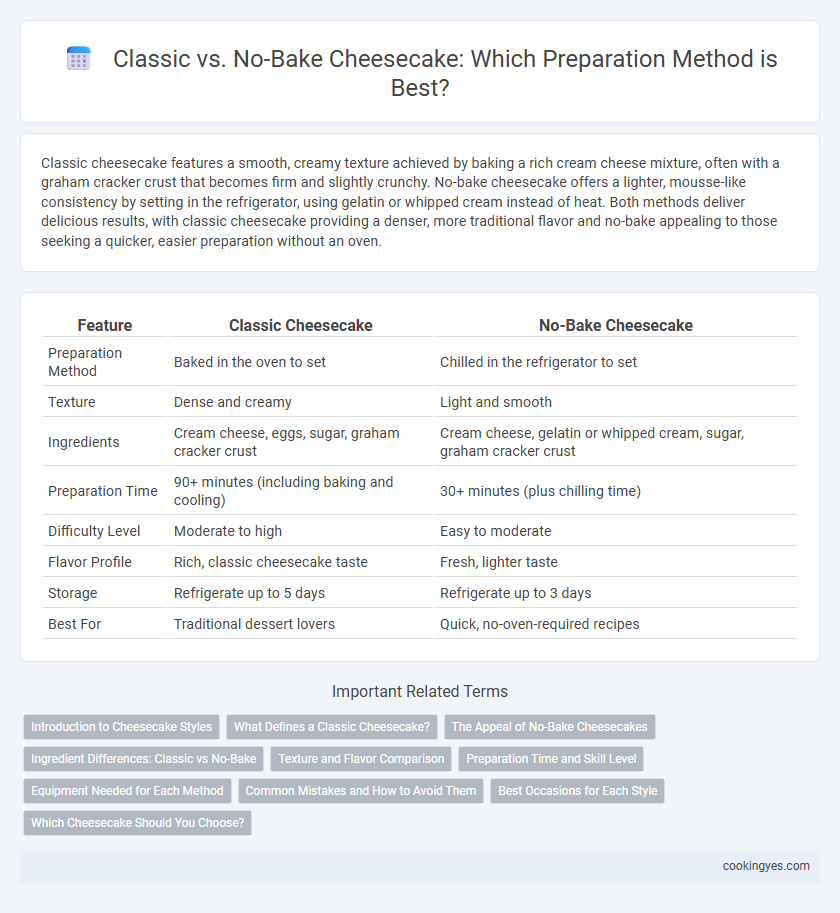Classic cheesecake features a smooth, creamy texture achieved by baking a rich cream cheese mixture, often with a graham cracker crust that becomes firm and slightly crunchy. No-bake cheesecake offers a lighter, mousse-like consistency by setting in the refrigerator, using gelatin or whipped cream instead of heat. Both methods deliver delicious results, with classic cheesecake providing a denser, more traditional flavor and no-bake appealing to those seeking a quicker, easier preparation without an oven.
Table of Comparison
| Feature | Classic Cheesecake | No-Bake Cheesecake |
|---|---|---|
| Preparation Method | Baked in the oven to set | Chilled in the refrigerator to set |
| Texture | Dense and creamy | Light and smooth |
| Ingredients | Cream cheese, eggs, sugar, graham cracker crust | Cream cheese, gelatin or whipped cream, sugar, graham cracker crust |
| Preparation Time | 90+ minutes (including baking and cooling) | 30+ minutes (plus chilling time) |
| Difficulty Level | Moderate to high | Easy to moderate |
| Flavor Profile | Rich, classic cheesecake taste | Fresh, lighter taste |
| Storage | Refrigerate up to 5 days | Refrigerate up to 3 days |
| Best For | Traditional dessert lovers | Quick, no-oven-required recipes |
Introduction to Cheesecake Styles
Classic cheesecake features a dense and creamy texture achieved through baking a mixture of cream cheese, eggs, and sugar, often with a graham cracker crust, offering a rich and firm dessert experience. No-bake cheesecake relies on refrigeration rather than baking, using gelatin or whipped cream to set the filling, resulting in a lighter, mousse-like consistency with a delicate flavor. Both styles highlight variations in preparation techniques and texture, catering to different taste preferences and serving occasions.
What Defines a Classic Cheesecake?
A classic cheesecake is defined by its rich, dense texture achieved through baking a mixture of cream cheese, sugar, eggs, and vanilla, often on a graham cracker crust. The baking process allows the proteins to set and the flavors to meld, resulting in a smooth, creamy consistency with a slight tang from the cheese. Unlike no-bake cheesecakes, which rely on refrigeration to firm up with gelatin or whipped cream, classic cheesecakes offer a more traditional, custard-like quality.
The Appeal of No-Bake Cheesecakes
No-bake cheesecakes attract dessert lovers with their creamy texture and quick preparation, eliminating oven use and reducing baking errors. Their light, mousse-like consistency contrasts the dense, rich flavor of classic baked cheesecakes, appealing to those who prefer a softer, refreshing dessert. The convenience of no-bake recipes suits warmer climates and busy schedules, making them a popular alternative in modern dessert menus.
Ingredient Differences: Classic vs No-Bake
Classic cheesecake relies on a rich blend of cream cheese, eggs, sugar, and heavy cream, which requires baking to achieve its dense and creamy texture. No-bake cheesecake uses cream cheese, whipped cream or gelatin, and sweeteners without eggs, eliminating the need for oven time and resulting in a lighter, mousse-like consistency. The absence of eggs and baking in no-bake recipes makes them quicker to prepare but with a different texture and flavor profile compared to the traditional baked classic cheesecake.
Texture and Flavor Comparison
Classic cheesecake features a dense, creamy texture achieved through baking, offering a rich, tangy flavor from cream cheese and eggs. No-bake cheesecake presents a lighter, mousse-like consistency with a smoother, sweeter taste due to the absence of eggs and the use of gelatin or whipped cream. Texture differences are significant as baked cheesecakes firm up, while no-bake versions remain soft and airy, affecting mouthfeel and overall flavor perception.
Preparation Time and Skill Level
Classic cheesecake requires baking at a low temperature for 50 to 60 minutes and needs intermediate baking skills to achieve the perfect texture. No-bake cheesecake typically takes 15 to 20 minutes to prepare and 4 hours to set in the refrigerator, making it ideal for beginners due to its straightforward assembly. Preparation time and skill level distinctly influence whether bakers choose the dense, creamy richness of classic cheesecake or the light, mousse-like softness of no-bake versions.
Equipment Needed for Each Method
Classic cheesecake preparation requires essential equipment such as a springform pan for easy removal, a water bath to ensure even baking and prevent cracking, and a mixer to achieve a smooth batter consistency. No-bake cheesecake only needs a mixing bowl, an electric mixer or whisk for blending cream cheese and other ingredients, and a refrigerator for setting, eliminating the need for an oven or water bath. The equipment differences significantly affect preparation time and texture outcomes, with classic cheesecake demanding more specialized tools.
Common Mistakes and How to Avoid Them
Classic cheesecake often suffers from overbaking, causing cracks and a dense texture; to avoid this, bake in a water bath and monitor internal temperature closely. No-bake cheesecake mistakes include insufficient chilling time, which leads to a soft, unstable dessert; ensure refrigeration for at least 4-6 hours or overnight for proper setting. Both methods require using room-temperature ingredients to achieve a smooth, creamy consistency and prevent curdling or lump formation.
Best Occasions for Each Style
Classic cheesecake, baked to achieve a dense and creamy texture, is ideal for formal events and holiday dinners where a rich dessert is expected. No-bake cheesecake offers a lighter, mousse-like consistency perfect for casual gatherings, summer picnics, or quick dessert fixes without an oven. Choosing between these styles depends on the occasion's formality, time constraints, and preferred texture.
Which Cheesecake Should You Choose?
Classic cheesecake offers a rich, dense texture achieved through baking with cream cheese, eggs, and sugar, resulting in a velvety consistency and a golden crust. No-bake cheesecake provides a lighter, creamier alternative that sets in the refrigerator using gelatin or whipped cream, ideal for quick preparation and a softer bite. Choose classic cheesecake for a traditional, firm dessert with depth of flavor, while no-bake suits those seeking convenience and a refreshing, airy texture.
Classic vs no-bake for cheesecake preparation Infographic

 cookingyes.com
cookingyes.com